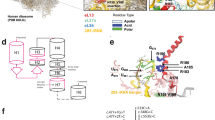Abstract
Spondylocostal dysostosis (SD, MIM 277300) is a group of vertebral malsegmentation syndromes with reduced stature resulting from axial skeletal defects. SD is characterized by multiple hemivertebrae, rib fusions and deletions with a non-progressive kyphoscoliosis. Cases may be sporadic or familial, with both autosomal dominant and autosomal recessive modes of inheritance reported1. Autosomal recessive SD maps to a 7.8-cM interval on chromosome 19q13.1–q13.3 (ref. 2) that is homologous with a mouse region containing a gene encoding the Notch ligand delta-like 3 (Dll3). Dll3 is mutated3 in the X-ray–induced mouse mutant pudgy (pu), causing a variety of vertebrocostal defects similar to SD phenotypes. Here we have cloned and sequenced human DLL3 to evaluate it as a candidate gene for SD and identified mutations in three autosomal recessive SD families. Two of the mutations predict truncations within conserved extracellular domains. The third is a missense mutation in a highly conserved glycine residue of the fifth epidermal growth factor (EGF) repeat, which has revealed an important functional role for this domain. These represent the first mutations in a human Delta homologue, thus highlighting the critical role of the Notch signalling pathway and its components in patterning the mammalian axial skeleton.
This is a preview of subscription content, access via your institution
Access options
Subscribe to this journal
Receive 12 print issues and online access
$209.00 per year
only $17.42 per issue
Buy this article
- Purchase on Springer Link
- Instant access to full article PDF
Prices may be subject to local taxes which are calculated during checkout




Similar content being viewed by others
References
Mortier, G.R., Lachman, R.S., Bocian, M. & Rimoin, D.L. Multiple vertebral segmentation defects: analysis of 26 new patients and review of the literature. Am. J. Med. Genet. 61, 310–319 (1996).
Turnpenny, P.D. et al. A gene for autosomal recessive spondylocostal dysostosis maps to 19q13.1–q13.3. Am. J. Hum. Genet. 65, 175–182 (1999).
Kusumi, K. et al. The mouse pudgy mutation disrupts Delta homologue Dll3 and initiation of early somite boundaries. Nature Genet. 19, 274–278 (1998).
Conlon, R.A., Reaume, A.G. & Rossant, J. Notch1 is required for the coordinate segmentation of somites. Development 121, 1533–1545 (1995).
de Angelis, M.H., McIntyre, J.I. & Gossler, A. Maintenance of somite borders in mice requires the Delta homologue Dll1. Nature 386, 717–721 (1997).
Evrard, Y.A., Lun, Y., Aulhehla, A., Gan, L. & Johnson, R.L. lunatic fringe is an essential mediator of somite segmentation and patterning. Nature 394, 377–381 (394).
Zhang, N. & Gridley, T. Defects in somite formation in lunatic fringe -deficient mice. Nature 394, 374–377 (1998).
Dunwoodie, S.L., Henrique, D., Harrison, S.M. & Beddington, R.S.P. Mouse Dll3: a novel divergent Delta gene which may complement the function of other Delta homologues during early pattern formation in the mouse embryo. Development 124, 3065–3076 (1997).
Turnpenny, P.D., Thwaites, R.J. & Boulos, F.N. Evidence for variable gene expression in a large inbred kindred with autosomal recessive spondylocostal dysostosis. J. Med. Genet. 28, 27–33 (1991).
Casamassima, A.C. et al. Spondylocostal dysostosis associated with anal and urogenital anomalies in a Mennonite sibship. Am. J. Med. Genet. 8, 117–127 (1981).
Delgoffe, C. et al. Dysostoses spondylocostales et cardiopathies congénitales. Ann. Pédiat. 29, 135–139 (1982).
Simpson, J.M., Cook, A., Fagg, N.L.K., MacLachlan, N.A. & Sharland, G.K. Congenital heart disease in spondylothoracic dysostosis: two familial cases. J. Med. Genet. 32, 633–663 (1995).
Bonaime, J.L. et al. Le syndrome de dysostose spondylothoracique ou spondylocostale. Pédiatrie 33, 173–188 (1978).
Robbins, J., Blondel, B.J., Gallahan, D. & Callahan, R. Mouse mammary tumor gene int-3: a member of the notch gene family transforms mammary epithelial cells. J. Virol. 66, 2594–2599 (1992).
Lardelli, M., Dahlstrand, J. & Lendahl, U. The novel Notch homologue mouse Notch 3 lacks specific epidermal growth factor-repeats and is expressed in proliferating neuroepithelium. Mech. Dev. 46, 123–136 (1994).
Lardelli, M. & Lendahl, U. Motch A and motch B–two mouse Notch homologues coexpressed in a wide variety of tissues. Exp. Cell. Res. 2, 364–372 (1993).
Ellisen, L.W. et al. TAN-1, the human homolog of the Drosophila notch gene, is broken by chromosomal translocations in T lymphoblastic neoplasms. Cell 66, 649–661 (1991).
Weinmaster, G., Roberts, V. & Lemke, G. A homolog of Drosophila Notch expressed during mammalian development. Development 113, 931–941 (1991).
Bettenhausen, B., Hrabe de Angelis, M., Simon, D., Guenet, J.L. & Gossler, A. Transient and restricted expression during mouse embryogenesis of Dll1, a murine gene closely related to Drosophila Delta. Development 121, 2407–2418 (1995).
Li, L. et al. Alagille syndrome is caused by mutations in human Jagged1, which encodes a ligand for Notch1. Nature Genet. 16, 243–251 (1997).
Oda, T. et al. Mutations in the human Jagged1 gene are responsible for Alagille syndrome. Nature Genet. 16, 235–242 (1997).
Sidow, A. et al. Serrate2 is disrupted in the mouse limb-development mutant syndactylism. Nature 389, 722–725 (1997).
Lindsell, C., Shawber, C., Boulter, J. & Weinmaster, G. Jagged: a mammalian ligand that activates Notch1. Cell 80, 909–917 (1995).
Johnston, S.H. et al. A family of mammalian Fringe genes implicated in boundary determination and the Notch pathway. Development 124, 2245–2254 (1997).
Cohen, B. et al. Fringe boundaries coincide with Notch-dependent patterning centres in mammals and alter Notch-dependent development in Drosophila. Nature Genet. 16, 283–288 (1997).
Joutel, A. et al. Notch3 mutations in CADASIL, a hereditary adult-onset condition causing stroke and dementia. Nature 383, 707–710 (1996).
Greenwald, I. Structure/function studies of lin-12/Notch proteins. Curr. Biol. 4, 556–562 (1994).
Thomas, U., Speicher, S.A. & Knust, E. The Drosophila gene Serrate encodes an EGF-like transmembrane protein with a complex expression pattern in embryos and wing discs. Development 111, 749–761 (1991).
Kopczynski, C.C., Alton, A.K., Fechtel, K., Kooh, P.J. & Muskavitch, M.A.T. Delta, a Drosophila neurogenic gene, is transcriptionally complex and encodes a protein related to blood coagulation factors and epidermal growth factor of vertebrates. Genes Dev. 2, 1723–1735 (1988).
Artavanis-Taskonas, S. Alagille syndrome—a notch up for the Notch receptor. Nature Genet. 16, 212–213 (1997).
Acknowledgements
We thank the families for cooperation; K. Maruthainar, K. Dewar and B. Birren for undertaking sequencing efforts; and the management and laboratory staff of The Nazareth Hospital, Israel for their help. This work was supported by the British Scoliosis Research Foundation, the Medical Research Council (UK), Action Research, the Skeletal Dysplasia Group (UK), the Children's Research Fund, the Darlington Charitable Trust, the Royal Devon & Exeter NHS Healthcare Trust and the University of Exeter. The assistance of the DNA Laboratories of the West Midlands Regional Genetics Service, Birmingham, the Yorkshire Regional Genetics Service, Leeds and the Kennedy-Galton Centre, London is appreciated. K.K. is supported by a Hitchings-Elion Fellowship of the Burroughs Wellcome Fund.
Author information
Authors and Affiliations
Corresponding author
Rights and permissions
About this article
Cite this article
Bulman, M., Kusumi, K., Frayling, T. et al. Mutations in the human Delta homologue, DLL3, cause axial skeletal defects in spondylocostal dysostosis. Nat Genet 24, 438–441 (2000). https://doi.org/10.1038/74307
Received:
Accepted:
Issue Date:
DOI: https://doi.org/10.1038/74307
This article is cited by
-
Molecular landscape of congenital vertebral malformations: recent discoveries and future directions
Orphanet Journal of Rare Diseases (2024)
-
Non-canonical non-genomic morphogen signaling in anucleate platelets: a critical determinant of prothrombotic function in circulation
Cell Communication and Signaling (2024)
-
Notch signaling pathway: architecture, disease, and therapeutics
Signal Transduction and Targeted Therapy (2022)
-
Zebrafish: an important model for understanding scoliosis
Cellular and Molecular Life Sciences (2022)
-
Recapitulating the human segmentation clock with pluripotent stem cells
Nature (2020)



